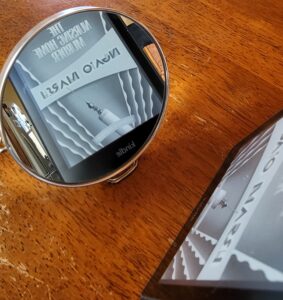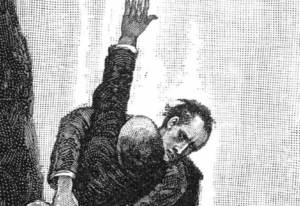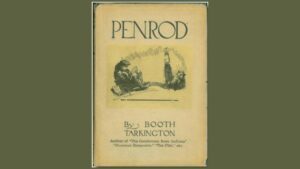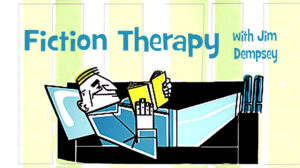Editing
Years ago, I read of an arrogant Ingénue who kept trying to upstage a more experienced actress. Finally, the actress threatened to upstage the Ingénue without even being on stage. The challenge was accepted.
The next performance included a scene where the actress was to make her exit holding a wineglass. She attached a piece of two-sided tape to the bottom of the glass, and just before she stepped offstage, she set it on a side table, hanging off the edge.
For the rest of the scene, the audience ignored the Ingénue and kept their eyes on that glass.
Sometimes your most riveting action can happen when your characters are offstage. You lead up to the key scene with enough detail that readers can see what’s about to happen, then you drop back and let their minds supply the rest. Of course, any writing is an ongoing collaboration between your words and your readers’ imaginations, but moving action offstage gives their imaginations free rein.
So when’s the right time to let your readers take over for you? Well, sex scenes. Some writers can create sex scenes whose details are steamy, reveal a character’s personality, and move the story along. But more often than not, just the fact that a couple of characters hook up is all your story needs. Besides, these scenes are notoriously hard to write well, if only because tastes vary — different people find different things steamy. If you move the explicit bits into the linespaces (as Renni and I put it in Self-Editing) then your readers can bring their own tastes and imaginations to bear. The results are often more enticing than a precise blow by blow.
Take this passage, from a manuscript I worked on recently – used with the client’s permission, of course. The main character, a professional racer, has just made a deal with her chief rival before a dangerous race – that they would both race clean, without risking one another. Then, since it’s an hour before race time, she suggests that they seal the deal, physically. Here’s the original version of the final paragraph of the scene:
She locked the door. His lips found the side of her neck. She flinched away again but then buried her neck back into his lips. She reached behind her to pull his face against hers with one hand, the other fumbling with his belt. His hand moved down her side, another up her shirt. She closed her eyes and sighed. She could accomplish a lot in an hour.
It’s hard to tell without the context, but these details don’t tell us much about the characters that we didn’t already know or move the story along in other ways. So for the edited version, I recommended that the writer simply lose the physical details, leaving only:
She locked the door. She could accomplish a lot in an hour.
[End scene.]
Another place you might want to shift the action offstage is when the emotional thrust of the scene lies in the fact of what happens rather than the details of how. Consider this situation, again taken from a recent client’s work with their permission. Helena, one of the principal characters, has murdered her husband. She then butchers him — literally, turning him into […]
Read MoreWhen one is a word nerd, one can fight against one’s nature—suppressing the automatic correcting of friends’ misused words…working to suppress a shudder when a newspaper (a damned newspaper! bastion of a free and informed society!) is rife (not ripe) with dangling modifiers…trying hard not to see that billboard that for the love of all things holy misuses an apostrophe for a pluralization as the SIGN OF THE GRAMMATICAL APOCALYPSE that it obviously is.
But our nature will out. I’ve been resisting another pedantic post on the vagaries of our vernacular, but then no less a linguistic luminary than Benjamin Dreyer (who was very remotely once my boss in the 15 years I was a freelance copyeditor for Random House, back before it osmosed into Penguin—where I was also a copyeditor) writes a Washington Post op-ed about rampantly misused words and I’m off the wagon.
Join me on my bender, fellow grammar geeks—here are a few banes of a recovering copyeditor’s existence. Today we’re diving into conjugational tomfoolery of some of American English’s most provocative participles.
Vexing Verb Variations
Here’s how some common verbs conjugate: Sink/sank/sunk, drink/drank/drunk, spring/sprang/sprung.
Some of these can be a bit counterintuitive—for instance, I can’t tell you how often I read, “She sunk into a chair,” where the writer is incorrectly employing the pluperfect conjugation despite writing in past tense. GAH.
For those who aren’t quite as geeky about grammar, pluperfect is also known as the past perfect—or as I like think of it in my shortcuts-for-dummies mentality (and by dummies, I mean me, the woman who still sounds out “Wed-nes-day” syllable by syllable to make sure I spell it right), the past-past tense. Or if we want to dumb it down even further, you can think of it as the “had” tense, as in, “The author of the blog post had never seemed so pedantic to her readers as she did at that moment” or “The writers’ site had been interesting until it was hijacked by an out-of-control editor.”
The pluperfect is the one I always advise authors to use care with, especially in flashbacks, where it can get a little thick and ridiculous—witness this perfectly correct sentence: “The yogurt she had had had had three weeks to turn green in the sink.” Ah, English, you whimsical little minx.
Pro tip: If you’re writing flashback scenes within a past-tense story, which is often where the pluperfect tense comes creeping in, signal that time shift to readers with a well-placed “had” or two here and there, but then drop it or your writing will seem cluttered, your reader will become weary, and you will seem a pretentious douchebag.
Back to sink/sank/sunk: The boat is about to sink; the boat sank last week; the boat had already sunk when Jack and Rose found the apparently single-occupancy door floating in the Atlantic.
The same applies to spring/sprang/sprung—although virtually no one uses sprang correctly. Nonetheless, he sprang out of his waterbed, which had sprung a leak.
For some reason drink/drank/drunk causes great consternation, as if using the correct pluperfect is a value judgment on someone’s tippling habits: After they drank the first bottle of wine, they reached for the second, but realized they had already drunk it. (At which point yes, perhaps indeed they were drunk, […]
Read MoreCourtesy of Jeffery, Creative Commons.
Let me tell you about a manuscript I worked on early in my career as an editor– actually when I was still apprenticing under my co-author, Renni Browne. This was back when manuscripts were still on paper and editing was done with a pencil, so both the title and the author’s name are lost to the mists of time. I’d give spoiler warnings, but I have no idea if the manuscript ever published.
Yet, this story still sticks with me decades later.
The manuscript was a fantasy set in a society on another planet with roughly renaissance-level development — well-organized city states governed by a strong, universal legal and moral code. The story is told from the point of view of an inspector – something between an inquisitor and a detective – who is called in after a soldier killed a disabled, local boy who he said threatened him. The boy’s grandmother, a retired soldier in her own right, pulls her weapons out of storage, kills the soldier who killed her grandson, then disappears. The inspector is charged with bringing her to justice.
But as he digs into the case, he discovers that justice lies on the grandmother’s side. The soldier was drunk when he killed the young boy, who was innocent. Worse, the platoon leader tried to sweep the whole thing under the rug. The inspector discovers this when the grandmother, recognizing that he’s an honorable man, sneaks into his room at night and tells him her side of the story. So despite constant pressure, the inspector refuses to back down and declare the murdering soldier innocent because that would make him complicit in the coverup. The pressure is not unreasonable, since under their laws, every unit in the army maintains its cohesion by becoming a unified whole. If one member is dishonored, all are dishonored. This means that if he judges against the platoon leader, he would be condemning every other member of the platoon to death. Still, he feels that supporting a lie would corrupt their entire society, and he cannot do it. He has no choice but to stick with the truth.
The story comes to a head when the grandmother again comes out of hiding, kills several other members of the platoon, and is shot herself. Afterwards, as the inspector is preparing the report exonerating her, the company commander orders him to let it go, to declare the soldier innocent and the grandmother guilty, for the good of everyone. Once again, he is alone, fighting for honor against the corruption and lies that would destroy everything he believes in. He feels he has no choice but to declare the company commander has fallen into dishonor.
And then, in one sudden flash, he sees that he has just condemned thousands of soldiers to their deaths. And he just can’t do it. He leaves his report unfinished and simply walks away from the situation, the army, his career as an inspector, and his entire life.
So what makes this epiphany brilliant enough that it’s still with me 35 years later?
First, it comes as a complete surprise. Plot twists in general work best when you can’t see them coming, and that’s particularly true […]
Read More
I’ve been working on a new novel for a while now. After two years of steady work, I completed the first draft of the manuscript in January. Since then, I’ve been spending nearly every minute of my writing time revising all three-hundred-plus pages of it line by line. I’m currently working on my fourth round of these revisions, after which I might* be happy enough with the book to send it out to beta readers. It’s been a long process, so time consuming and, at times, tedious that I began to wonder whether other writers also scrutinize each of their sentences multiple times when trying to finalize their work, or if I’m alone in my OCD-like obsession with synonyms, syntax, and eliminating modifiers.
Hoping to discover more efficient revision techniques, I asked four other authors what they do to get their manuscripts into shape both before and after readers, agents, and editors have put in their two cents.**
Liz Michalski, author of Evenfall and Darling Girl, told me she sets aside a week or two to take care of final edits before anyone else sees her work. This includes running grammar and spelling checks in two different programs and pasting each chapter into text-to-speech software and listening to it. She also reads chapters out of order, which she says is a great way to catch continuity errors.
When it comes to recommendations from readers and editors, Michalski says the suggestions she initially disagrees with most are usually the ones she circles back to at the end. “I re-read them a few weeks later with a clear head. Getting my ego out of the process often reveals their true value,” she says.
Author of Chasing Alaska, Small Animals Caught in Traps, and Ordinary Bear, which was released this month, C.B. Bernard says his revisions mirror his writing process. “Because I don’t work front-to-back, it’s difficult to talk—or even think—about drafts,” he says. “A manuscript is dynamic, and I’m always monkeying. Occasionally, I’ll print it out and read it aloud and find all sorts of new issues. When I think it’s done done, I print and read it aloud again—and, of course, it’s not even close. Back to work, rinse, and repeat.”
Bernard says he often “triangulates” when deciding which advice from readers and editors to follow. “Say you let three people read a draft. If just one person gives you a note on something, hear them out but do it with a grain of salt. If all three give you the same note, you’ve found a speedbump that needs to be addressed,” he says. Bernard also says if he fundamentally disagrees with feedback, he’ll stand his ground. “If you make edits you can’t live with because you second-guessed yourself, it will haunt you, I promise,” he says.
Roz Morris, author of Ever Rest, Lifeform Three, Memories of a Future Life, and Not Quite Lost, says it’s difficult for her to tell at what point revising becomes final editing. “Ever Rest went through twenty-one drafts,” she says. “I revise a lot, noticing nuances and making refinements all the time, so […]
Read More“If this were a Sherlock Holmes case, he would discover ash [at the crime scene] that came from a tobacco sold by only one tobacconist in London, who has only one customer.” G. K. Chesterton
I’ve written before about how I will reflexively edit out anything in your writing that calls your readers’ attention to the fact that they’re reading a book — foreshadowing, asides to the reader, heavy-handed narrative voice that is the same for all characters. Everything must go.
And yet, I’ve always had a soft spot for self-reference – those little observations where the writer uses characters in their stories to make comments about the stories themselves, or other stories, or the genre as a whole. The quote above delighted me enough that it’s been lodged in my memory for decades, though I can no longer remember where it came from and couldn’t find it on the internet. I remember it as being from G. K. Chesterton’s Father Brown series, but I’m not sure. Maybe readers can help. [Thanks to Christine Robinson for tracking this down — it was Chesterton.]
Self-referential asides often act as inside jokes – a nod and a wink to readers, inviting them to compare the story they’re reading to other stories. It’s tricky to do this without reminding them they’re reading a story. This is why self referential asides work best in lighter novels. And as I’ve written before, readers are more willing to hold onto suspension of disbelief when the entire novel is being played for fun. This is why The Hitchhiker’s Guide to the Galaxy can get away with the book-within-the-book commenting on the action of the book.
Subtler self-reference comments on the action can often be blended into the story if they come from the characters themselves, as in the Chesterton (?) quote. After all, Chesterton’s characters had also read Sherlock Holmes. The point of that quote was to show how real police work wasn’t like fictional detective work because real policemen relied on hard, investigative effort rather than special knowledge and luck. That’s something a real detective might feel. And this makes readers less likely to notice that the speaker isn’t a real detective but is as fictional as Sherlock Holmes. The character is comparing the case he’s currently working on to Conan Doyle’s work, and that all happens within the context of the story. And, if I remember correctly, the Chesterton (?) story has the added twist that the case is eventually solved by specialized knowledge and luck.
Ruth is currently reading Ngaio Marsh’s Inspector Allyn books and finding a lot of examples of this sort of in-world self-referential commentary. (Incidentally, Ruth often contributes enough to these articles to deserve co-author credit.) For instance, there’s this from The Nursing Home Murders. Inspector Allyn and his friend Nigel Bathgate are reviewing the possible suspects, whom Nigel refers to as the “dramatis personae.” Then Allyn asks whom Nigel would pick.
“For a win,” Nigel pronounces at last, “the special nurse. For a place the funny little man.”
“Why?”
“On the crime-fiction line of reasoning. The two outsiders. The nurse looks very fishy. And funny little men are rather a favorite line in villains nowadays. He may turn out to be Sir […]
Read MoreSo often in the craft of writing authors are presented with black-and-white dos and don’ts, foolproof systems for creating best-selling stories, story-craft dogma accepted as gospel despite our industry being entirely built on absolutely subjective opinion: from beta reader feedback to what will appeal to agents and publishers to what sells in any given market to wildly varying critical and online reviews of the exact same book.
Despite that I have worked 30 years in this business offering exactly that—opinions and advice about what makes story effective—I do not like writing rules.
I’m a staunch proponent of the idea that every story is unique, as is every author creating it, and that effective stories grow from the inside out, not by having a rigid system or set strictures imposed on it from the outside in. I base all of my work as an editor—and the entire premise of my book Intuitive Editing (where I even put the word “rules” in quotes every time I use it)—on this idea.
But (always a but)…! It’s true that human beings tend to respond to story in largely predictable and conventional ways, our brains predisposed for certain storytelling conventions. It’s true that there are market realities, genre expectations, reader expectations. We can forge our own path in telling our stories, but the ultimate litmus test of whether they work is how well they engage and affect the reader. And this is something that we can learn by mastering and intentionally wielding elements of story craft that can elicit those results.
And yet invariably when I’m teaching a workshop, someone will bring up exceptions to every guideline for successful storytelling. I call this the “James Bond never changes” phenomenon, from a common comment I hear when speaking about character arcs.
And sure enough there are plenty of successful stories where characters don’t change. (I’m looking at you, Forrest Gump and John Wick.) Plenty of stories that don’t build to a clear climax (hello, Cloud Atlas), where characters don’t seem to have clear driving goals (’sup, Lebowski?), where so many of what we construe as the holy grails of storytelling simply don’t apply (I see your weird ass, The Lobster). And yet the story is still successful, whether critically or in its sales or in its audience devotion.
So while in my speaking, teaching, and writing about writing I usually cite stories that successfully illustrate effective use of the storytelling techniques I’m teaching about, after finishing a recent book I really enjoyed that conformed to very few of these “rules,” I thought it might be useful to analyze how it breaks them and succeeds anyway.
Why this story shouldn’t work
Jhumpa Lahiri’s The Namesake was recommended to me by a friend as her favorite novel (as much a subjective gray area of a concept as are storytelling “rules”).
Lahiri’s debut novel, published in 2003, followed her 1999 Pulitzer Prize–winning collection of short stories, Interpreter of Maladies. It received a very healthy number of high-profile good reviews, and also this painfully tepid one from Publishers Weekly. It has a 4.3 rating on Amazon with just over 10K reader reviews, more than 500 of which are 1- and 2-stars, and nearly 1,100 […]
Read More
In the comments section of last month’s article on how series can go astray, someone asked how to set up a sequel for readers who haven’t read the first book. How much recapping of the first book do you need to do to bring them up to speed?
The answer, almost always, is less than you think.
Ask yourself how much your sequel’s plot answers questions you raised in the first book. Most of the time – in most mystery series, for instance — the plot of your sequel is completely independent of what came before. There may be aspects of your characters’ lives that develop from book to book. But the stories themselves are self-contained, with the end of the book answering the questions asked at the beginning. Readers don’t need a recap on the history of the friendship between Archie and Fritz in every new Nero Wolfe novel.
Or consider how an expert – Sue Grafton – does it.
The opening paragraph of A is for Alibi is all background on Kinsey Milhone – her age, where she lives, why she likes where she lives, what she does. Less than a page later, we get a paragraph on her office and the nature of her business. This is a fair amount of background right off the bat, but it’s easier to digest because we get it all in Kinsey’s distinctive voice. (“I don’t have pets. I don’t have houseplants. I spend a lot of time on the road and I don’t like leaving things behind.”) The information is also mixed with the fact that she’d just killed someone for the first time, which catches readers’ attention despite the information dump. And the background is over by the middle of page two, when we’re into the main plot.
The opening pages of Y is for Yesterday (setting aside the first chapter, which is effectively a prologue) give us, if anything, even less information, even though there are 24 whole books of background behind them by this point. Same breezy voice (“I’m also single and cranky-minded, to hear some people tell it.”). Same quick summary of Kinsey’s living situation, her landlord, and the weather at the moment. Same shocking revelation — that she was recently nearly killed and has since gotten a concealed carry permit and stopped jogging at night – to heighten the tension. And within just a couple pages, we’re in the middle of the current case.
The recapping question gets trickier when the plots of the two books are sort of intertwined – where what happened in the previous book affects decisions made in the current one. Over the 32 books of Anne Perry’s Pitt series, Pitt moves from being a police inspector to being knighted by Victoria. In between, he goes through various career ups and downs, and his feelings about recent changes affect how he reacts in the current crisis. When this happens, Perry inserts only as much information as readers need to understand what’s going on.
If you’re in this situation, you can also work background in unobtrusively with interior monologue – current events remind your characters of what came before. Or you can have a recurring character fill in a new character […]
Read MoreAs some of you may already know, in addition to being a highly sought-after shirtless model for romance novel covers, I am also a longtime professional musician, having earned my first money for playing drums at the ripe old age of 14. In fact, music was my fulltime profession until my late 30s. And I didn’t start seriously writing fiction (inasmuch as anything I write could be considered “serious”) until I turned 40. (So you might say that as a writer, I was a 40-year-old virgin. But I digress…)
Coming into a new-to-me art form with a lengthy background in another, I’ve been repeatedly struck by how many parallels I’ve encountered between the two creative paths. It has also been interesting to note the very different experience of learning one art form as a child, and learning another as an adult (inasmuch as a person like me could ever be considered an “adult”).
But I’ll leave the exploration of the whole young-versus-old-artist rabbit hole for some other day. Today, I want to explore five similarities I’ve found in pursuing two art forms – writing and music – at the professional level. I’ll start with the one I think is most important:
1. It’s a business.
Thus far I’ve been calling them art forms, but when you start actively seeking a paying audience for your work – whether written or musical – you quickly become aware that you are dealing with a business, which brings with it numerous rules, obstacles and rites of passage, many of which are not clearly stated or even openly acknowledged. Yeah, it’s fun like that. Trust me: You’re gonna want to wear a helmet.
In each case, because it’s a business, many decisions that will affect your success are A) based on money, and B) out of your hands.
As a musician, this could come down to who is willing to hire you, or to pay to see you perform, or to publish your music (an area that used to be where the money was in songwriting), or to finance your recording and/or tour, or to buy your recordings. Bottom line: It’s about who will spend their money on this thing you chose to do. As the artist, all you can do is make whatever product or service you’re offering as appealing – and as competitive in terms of financial value – as possible.
Writers are in a similar position. Whether you’re pursuing the traditional publishing route, or self-publishing, or trying to get a piece of your dramatic work produced either on stage or screen, somebody else has to decide that what you’re doing (or promising to do) is worth their money.
In both cases, as an artist, you are free to express yourself in any way you see fit. But as an artist who wants to be paid for that art, it quickly becomes obvious that some pathways lead a bit more directly to potential revenue generation than others. Hence my next observation:
2. Genre matters.
For example, a thrilling 70,000-word whodunit with a strong, confident protagonist stands a better chance of selling some copies than a 600-page second-person diatribe exploring the modernist paradigm of discourse that forces the reader to choose between subcapitalist situationism and the dialectic paradigm of consensus. (Incidentally, I have no […]
Read MoreHolmes dealing with his Nemesis
I’ve been reading some of the last few of Anne Perry’s 32 Thomas Pitt mysteries, centered around the late 19th century detective. (Sadly, Ms. Perry died in April of last year. She will be missed.) It’s been fun to watch how Ms. Perry developed her skills over the course of the run. For instance, she did eventually kick the habit of describing faces as a way to convey emotion. But these last few books show a problem common to a lot of longer series – feature creep.
At the start, Pitt solved murders as a police detective in London. As the series went on, he tracked serial killers, then battled conspiracies within the government. This got him kicked out of the police, but he was picked up by Special Branch, where he continued the fight. Toward the end, he saved the reputation of the Crown Prince, the life of Queen Victoria, and ultimately the Empire. And while Ms. Perry’s skills as a writer made much of this plausible, mostly by rooting it in Pitt’s character, I still wonder, if the series had continued for a few more volumes, would Pitt have prevented WW1?
There are lot of good reasons for writing a series. One of the pitfalls is, how do you keep from repeating yourself – the Bond books get formulaic pretty quickly — without pushing your stories to increasingly high stakes? A lot of great series run into this problem. After Doyle tried unsuccessfully to kill off Sherlock Holmes, the stories grew more unfocused. Watson’s wife disappeared, a lot of stories were nostalgic looks back at decades-old cases, and Holmes eventually retires and raises bees. The series ends with Holmes and Watson coming out of retirement to shut down a German spy operation on the eve of WW1.
One way to keep a series fresh is to introduce a nemesis – an ongoing villain to give the villain’s side of the story as much continuity and growth as the hero’s. A nemesis lets you reveal new details of how deeply they have their tendrils into society, giving the hero new and deeper flavors of evil to overcome with each book. In Pitt’s battle with the secret society within the halls of government, he uncovers links to colleagues around him he wouldn’t have expected. Rex Stout gave Nero Wolfe a nemesis in the form of criminal mastermind, Arnold Zeck, whom Wolfe pursued over the course of three novels. Even Doyle helped speed Holmes to his death by introducing Moriarty.
But nemeses rarely last for long without themselves becoming formulaic. The existence of SMERSH didn’t keep the Bond books from repeating themselves. Arnold Zeck only lasted for three novels before Wolfe managed to take him out and return to mysteries with a smaller, often more personal focus.
Another way to keep a series from falling apart is introducing new characters or new revelations about old characters. Elizabeth Peters’ Amelia Peabody Emerson series, which runs from late Victorian days to the thirties, is primarily centered around Amelia, her husband Radcliff, and their immediate family, all Egyptologists. But the cast eventually grows to hard-to-manage proportions. We meet various distant cousins and […]
Read MoreOnce again, serendipity gave me this month’s topic. Not long after I put up last month’s piece on cultural appropriation, the New York Times published an article on the controversy around plans to rewrite the works of Georgette Heyer. Ms. Heyer, who wrote from the 1920s to the 1970s, essentially created the modern Regency romance.
She’s delightful to read in a lot of ways. I love her use of early 19th century language, but her Jewish characters are cruel stereotypes. Her estate has agreed to a new edition of her books with the anti-Semitism edited out. It’s about time.
The NY Times article argued both sides of the question. Readers are generally smart enough to see that things were different in the past, so posthumous rewriting to fit more modern sensibilities is unfair to the author. On the other side, the racist language of the past may be so offensive that some readers will be unable to read it at all.
In Ms.Heyers’ case, the offensive characters are relatively minor and easily rewritten to erase any antisemitism. In fact, because the characters are stereotypes, the book is stronger without them.
In other cases, the racism is so interwoven in the narrative that the story can’t be saved. For instance, I couldn’t get through Gone With the Wind. I mean, yes, great characters, wonderful romance, historic sweep, all of that. But I couldn’t get past the Lost Cause narrative – that the Confederacy may have lost the war, but, gosh darn it, they were right all along. The book can be taught in academic settings, where a teacher can give the cultural context, but by now it is more a historical document about the bad old days than popular entertainment.
Then there’s Booth Tarkington.
The house I grew up in didn’t have many books, and I think I read all of them – my older sister’s Bobbsey Twins collection, Oliver Twist (when I was far too young to follow it), a 19th-century edition of Pilgrim’s Progress, with woodcuts. And Penrod and Sam, a collection of short stories by Booth Tarkington. Later in life, I got hold of the first book in the series, Penrod.
Both books tell stories of Penrod Schofield, a boy growing up somewhere in the Midwest just after the turn of the 20th century. Two of Penrod’s friends were black, the brothers Herman and Verman. (That is correctly spelled, by the way. As Herman explains when they first meet Penrod, their parents just like rhyming names — they also have an older brother Sherman.) Because Tarkington was a product of his time, the brothers are often described using racist language. But . . .
In one of the stories from Penrod, Penrod has to stay in town while most of his friends visit relatives in the country to escape the summer city heat. While on his own, Penrod meets a bully, Rupe Collins, who menaces and humiliates him. And in one of the nice bits of characterization that make Tarkington worth reading, Penrod falls straight into hero worship. He starts spending more time with Rupe and emulating him. When Sam returns from the country and runs into Rupe and Penrod, Penrod encourages Rupe to bully Sam the way Rupe bullied him. Rupe is […]
Read MoreBack when I was the editor of a regional lifestyle magazine, I discovered that one of the photographers we worked with had a bachelor’s degree in music and that he had once worked as a professional musician. In her former career, an interior designer who was a consultant for the magazine had been a sought-after portrait photographer. Our creative director, a skilled graphic designer, had a side gig working as a comic book artist.
The writers I worked with were no different. One freelancer was an accomplished painter. Another made jewelry. A writer who was also the author of several books used to knit elegant sweaters and scarves in her spare time. Nearly every creative professional I met at that job seemed to possess talent and inspiration that allowed them to excel at more than one type of imaginative endeavor.
This inclination has also been seen in a number of famous writers. Sylvia Plath created works in oil, pen and ink, and collage. William S. Burroughs was known for his “gunshot” paintings. Lewis Carol was a talented photographer. Throughout his life, Henry Miller created more than two-thousand watercolors. Drawings and paintings made by e.e. cummings were frequently shown at galleries in New York.
Jack Kerouac, Mark Twain, Rudyard Kipling, Kurt Vonnegut, Elizabeth Barret Browning, and George Bernard Shaw were all known for their skills as visual artists.
Although I hadn’t thought about it much before working with a large group of creative people, this predisposition also applies to myself. In addition to writing, I paint with watercolors and sew some of my own clothes. I’m more or less addicted to embroidery.
I’ve found that the creative projects I take on that are not writing-related often help me find solutions when writer’s block strikes. Painting has helped me come up with new story ideas. Learning new creative skills has also helped me write more realistic characters. A pottery class I took last winter with my daughter made it possible for me to better develop a character in the novel I’m working on who is a professional potter.
For years, I’d wondered why so many writers and artists tend to be drawn to more than one type of creative pursuit, and why engaging in more than one kind of imaginative project seems to boost one’s overall creative abilities. The answer has to do with the way creative thinking works in the brain.
In a 1997 interview with Wired magazine, Steve Jobs, co-founder and former CEO of Apple, said that “Creativity is just connecting things.” It turns out that he was right.
In their 2015 book, Wired to Create, authors Scott Barry Kaufman and Carolyn Gregoire write that creativity is a complex process that requires the interaction and collaboration of multiple parts of the brain, some of which don’t typically work cooperatively in the brains of non-creative people.
According to Kaufman and Gregoire, in order to write a story or compose a concerto, the brain must work to engage and connect memories, physical motor skills, emotions, critical thinking skills, imagination, analytical aptitude, empathy, planning skills, and the ability to sort and ignore irrelevant information, among other cognitive processes.
The science behind […]
Read MorePhoto courtesy of Lost Places
As so often happens, last month’s comments section inspired this month’s column.
The commentor had written a fantasy story for a competition, and in order to create a sense of a strange and exotic world in as little space as possible, pulled a number of details from ancient China. The judges liked the story but ultimately rejected because they felt the commentor was writing about a culture not her own. As the judges said, great writers had done this in the past, but “nowadays, ethnicity and authenticity are more significant.”
So . . . when it is appropriate to create characters who belong to another culture or race or gender or orientation – someone with very different life experiences from your own?
First, a caveat. I am a 63-year-old straight white man who grew up in a thoroughly homogeneous culture – Wyoming Valley, Pennsylvania. Nearly the entire population was white, primarily settlers from Connecticut and Philadelphia overlaid with immigrants who came over from eastern Europe in the nineteenth century to work the mines. A mixed marriage at the time was Polish Catholic marrying Italian Catholic. I’ve never had to worry about the possibility of being shot during a traffic stop or that my family would cut off contact because I fell in love with the wrong person, and I’m sure I take that privilege for granted.
But given that caveat . . . part of the art of writing is putting yourself in someone else’s head. It should be possible to do that even with a character who has had very different life experiences from your own. That is, after all, what imagination is for. Abandoning this approach to fiction is what gave us the old joke about MFA programs producing a lot of first novels about MFA students struggling with their first novel.
On the other hand, stretching your imagination too far can present some dangers. Cultural appropriation is a thing. If you try to place your story in a culture different from your own or center your dramatic tension on the hardships faced by characters very different from yourself – i.e. write about experiences you haven’t lived – you run the risk of being shallow or exploitative or both. How do you put yourself in the head of someone very different from yourself without offending the very people you’re writing about?
First, this largely applies to realistic stories set in the modern world. If you’re writing from the point of view of a twelfth-century French peasant and get the attitudes wrong, you’re only going to upset a group of medieval historians. If you’re writing from the point of view of a methane-based floating jellyfish living in the clouds of Jupiter, then you don’t have to worry.
And most of the time, the question never arises. Most writers base their characters on themselves, so they tend to not stray too far from their lived experience to get their stories told. But sometimes, for dramatic reasons, you’re called on to write about someone who is further from yourself in critical ways. What should you watch for?
Back in 1999, I read an article in The Atlantic Monthly that stuck with me: “ Read More
One of the many things I genuinely enjoy about Writer Unboxed is the comments section after each article. The comments can often develop into a discussion that elaborates on the original topic and they can bring a range of perspectives on the subject.
Sophie Masson’s excellent article on working with an editor really stood out for me in the last month. In the comments, Barry Knister had a great questions about ‘knowing how to judge the judgments of an editor.’ Check out that discussion if you haven’t already because it has some great insight for anyone thinking of hiring an editor.
For me though, it got me asking another question. Where does an editor’s responsibility lie? Is it with the author –or to the readers, who will ultimately consume the product?
There is, of course, a strong argument that we editors are primarily responsible to the authors. After all, they or their publishers/agents are the ones paying for the service. But writing, and therefore editing, is not, and should not be, only about money. Editors also have an ethical responsibility.
Sure, much of that ethical responsibility is tied up in the contract with the author/publsher as the codes of conduct we sign up to when we become members of a professional editing society clearly state. The editor has to provide a quality service, often before a certain deadline.
The job of editing
My question, however, is about that service. To understand were our responsibility lies, we have to understand what it is we do.
We work on text. We revise or suggest revisions. These might be small-scale changes – commas and colons – or large-scale changes where we suggest major manuscript rewrites.
But what’s our ultimate purpose as we do this? Is it for the author to sell more books? That could be part of it, although the author will only sell more books if readers are happy with the edited text.
The text is, after all, intended to be read. And, for me, the editor’s job is about making sure the text is easier (for wont of a better word) to read. By that, I mean there should be no room (or at least as little room as possible) for the reader to misunderstand, misinterpret or be misled by the text.
In other words, the text should be as clear as possible for the reader to read. That’s one way of looking at it, at least.
Does that mean we are ultimately responsible to the readers, to make their experience the best it possibly can be?
Perhaps. But while we make and suggest all those revisions, we also have to respect the author’s intention – even when that intention is to confuse the reader (take a look at the example I used in an earlier article from Samuel Beckett’s Molloy).
Understanding readers
So, editors have to be sensitive to the author’s intentions, but surely we also have to be sensitive to the readers’ possible interpretations. That means understanding how readers will see the book while also understanding how the author wants the readers to see the book.
But what if there are no readers, beyond the author’s mother, for example? With experience, an editor can tell if that’s likely to be the case, and it’s better to not take that job and […]
Read MoreRecently, I did a little something with a client that felt like magic.
Or, let’s say, I did something that seemed pretty normal for me, but seemed to strike my client as magic: I helped her fill in a gap in the plot of her novel in a way that struck her as just exactly right, and in a way that was totally in tune with her own vision for her novel.
At which point she actually stopped me and said, “Hey, can you break down how you did that? I want to understand the process here.”
So: How exactly do you fill in plot holes in a novel?
After all, there are many different ways you could fill in that spot in the story you’re still a little fuzzy about. What makes one option superior to another? And what sort of process tends to yield that “just exactly right” solution?
Perhaps in the first version of our novel—the one that’s either in the outlining stage or a rather drafty first draft—you’ve got a bit of a mushy part in the middle. Meaning, you know what happens leading up to that point, and you know what has to happen afterward, but you’re just a bit vague, or just a bit dissatisfied, with what happens in the middle.
Let’s say it’s a historical novel, the story of an upper-class young man—I’ll call him Alfred—living in England in the 1860s. As the story starts, we learn that he’s been hopelessly in love with his best friend from boarding school, and they’re getting ready to part ways as this friend—I’ll call him Oscar—goes off to serve in the armed forces in India, which is currently under British rule. At the last moment, Alfred dares to confess his feelings for Oscar, but Oscar acts as if he has not heard, and heads off on his steamer without acknowledging that vulnerable confession.
Alfred is heartbroken, but he knows it’s probably for the best—if his father knew he was gay, he’d disown him. So Alfred goes to work with his dad in managing the family textile factories, and does his best to toe the (respectable, traditional) line. But inside, Alfred is dying—not just because Oscar is gone, and possibly in mortal danger, but because Alfred knows the conditions in his father’s factories are deplorable, and feels himself to be in moral jeopardy in taking over their management, as his father intends.
So Alfred takes to drink, and to seedy underworld liaisons—but along the way, he discovers that he loves the theater, and decides to buy one, and to become its proprietor. His father is incensed, and attempts to block the purchase, but an eccentric great-aunt intervenes—it’s a historic theater, and she thinks it would be a shame for it to be razed, as the city intends, and she never liked her brother much anyway.
Then Oscar returns from India and confesses his feelings for Alfred. And the two of them live HEA with all of Oscar’s wonderful, colorful theater friends.
That could be a fun story but…there are some definite gaps in the plot as it stands.
First: If Alfred was so afraid of his father’s disapproval when the story started, what gave him the nerve to stand up to his dad by saying […]
Read More




















